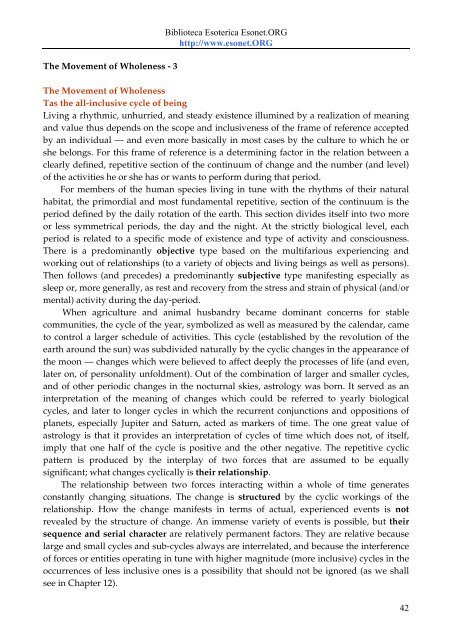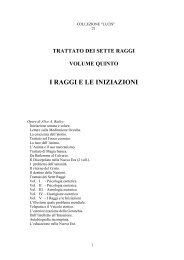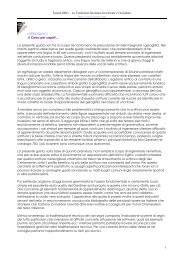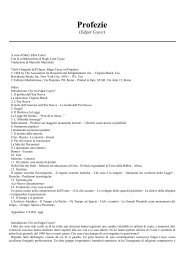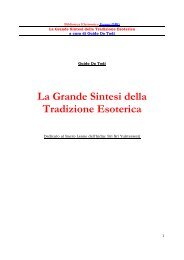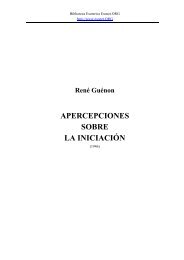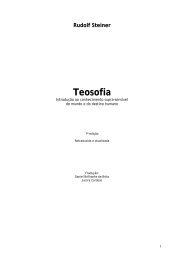Biblioteca Esoterica Esonet.ORG http://www.esonet.ORG 1
Biblioteca Esoterica Esonet.ORG http://www.esonet.ORG 1
Biblioteca Esoterica Esonet.ORG http://www.esonet.ORG 1
You also want an ePaper? Increase the reach of your titles
YUMPU automatically turns print PDFs into web optimized ePapers that Google loves.
The Movement of Wholeness - 3<br />
<strong>Biblioteca</strong> <strong>Esoterica</strong> <strong>Esonet</strong>.<strong>ORG</strong><br />
<strong>http</strong>://<strong>www</strong>.<strong>esonet</strong>.<strong>ORG</strong><br />
The Movement of Wholeness<br />
Tas the all-inclusive cycle of being<br />
Living a rhythmic, unhurried, and steady existence illumined by a realization of meaning<br />
and value thus depends on the scope and inclusiveness of the frame of reference accepted<br />
by an individual — and even more basically in most cases by the culture to which he or<br />
she belongs. For this frame of reference is a determining factor in the relation between a<br />
clearly defined, repetitive section of the continuum of change and the number (and level)<br />
of the activities he or she has or wants to perform during that period.<br />
For members of the human species living in tune with the rhythms of their natural<br />
habitat, the primordial and most fundamental repetitive, section of the continuum is the<br />
period defined by the daily rotation of the earth. This section divides itself into two more<br />
or less symmetrical periods, the day and the night. At the strictly biological level, each<br />
period is related to a specific mode of existence and type of activity and consciousness.<br />
There is a predominantly objective type based on the multifarious experiencing and<br />
working out of relationships (to a variety of objects and living beings as well as persons).<br />
Then follows (and precedes) a predominantly subjective type manifesting especially as<br />
sleep or, more generally, as rest and recovery from the stress and strain of physical (and/or<br />
mental) activity during the day-period.<br />
When agriculture and animal husbandry became dominant concerns for stable<br />
communities, the cycle of the year, symbolized as well as measured by the calendar, came<br />
to control a larger schedule of activities. This cycle (established by the revolution of the<br />
earth around the sun) was subdivided naturally by the cyclic changes in the appearance of<br />
the moon — changes which were believed to affect deeply the processes of life (and even,<br />
later on, of personality unfoldment). Out of the combination of larger and smaller cycles,<br />
and of other periodic changes in the nocturnal skies, astrology was born. It served as an<br />
interpretation of the meaning of changes which could be referred to yearly biological<br />
cycles, and later to longer cycles in which the recurrent conjunctions and oppositions of<br />
planets, especially Jupiter and Saturn, acted as markers of time. The one great value of<br />
astrology is that it provides an interpretation of cycles of time which does not, of itself,<br />
imply that one half of the cycle is positive and the other negative. The repetitive cyclic<br />
pattern is produced by the interplay of two forces that are assumed to be equally<br />
significant; what changes cyclically is their relationship.<br />
The relationship between two forces interacting within a whole of time generates<br />
constantly changing situations. The change is structured by the cyclic workings of the<br />
relationship. How the change manifests in terms of actual, experienced events is not<br />
revealed by the structure of change. An immense variety of events is possible, but their<br />
sequence and serial character are relatively permanent factors. They are relative because<br />
large and small cycles and sub-cycles always are interrelated, and because the interference<br />
of forces or entities operating in tune with higher magnitude (more inclusive) cycles in the<br />
occurrences of less inclusive ones is a possibility that should not be ignored (as we shall<br />
see in Chapter 12).<br />
42


